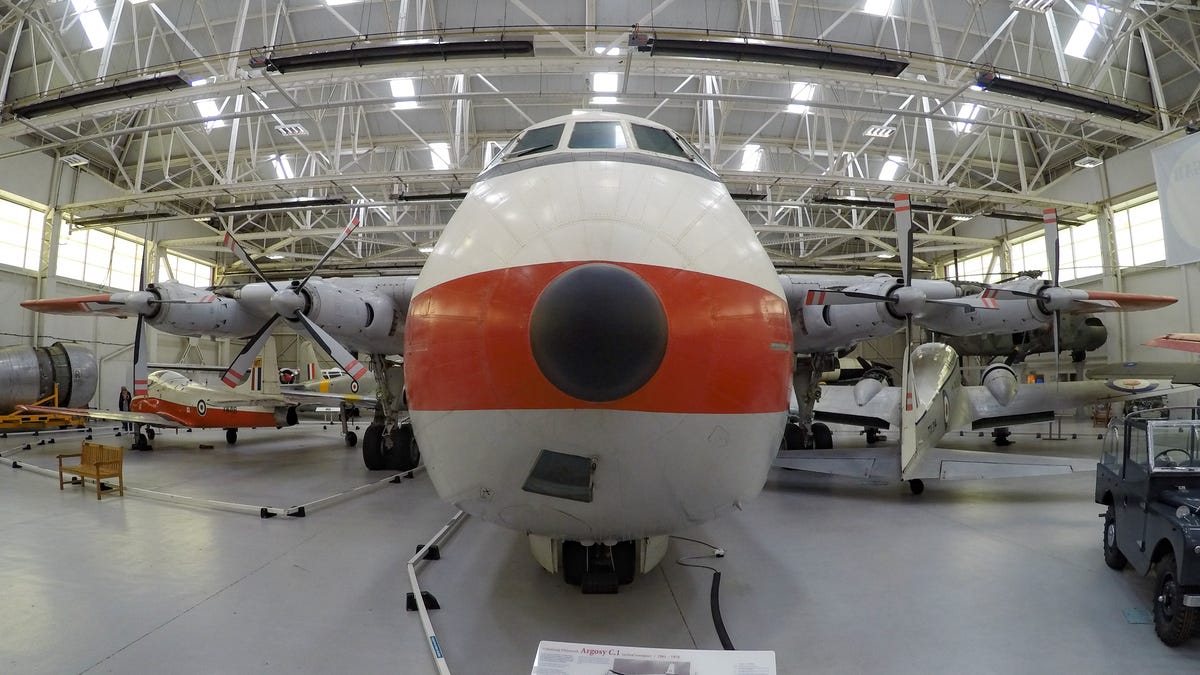 Why You Can Trust CNET
Why You Can Trust CNET Meet the jets and props of the Royal Air Force Museum Cosford
From a C-130 to a PBY Catalina to an Avro Vulcan, the Royal Air Force museum at Cosford in the UK houses dozens of incredible aircraft. Here's a full tour.

About 30 minutes outside of Birmingham, England, sits the Royal Air Force Museum Cosford. Spread across four main hangers and several buildings, it houses a fascinating collection of aircraft from both World Wars, the Cold War, and the modern era.
Some are even too big to house inside, like the massive Lockheed C-130 Hercules military transport, and a Hawker Siddeley Nimrod maritime patrol aircraft.
One beautifully designed hanger holds the National Cold War Exhibition, which goes beyond the planes themselves to take a look at the world during that era, with cars, tanks and other exhibits.
If your travel plans aren't taking you to the English Midlands any time soon, here's a look at the many planes and other attractions of the Royal Air Force Museum Cosford.
From propeller biplanes to jet bombers: the incredible planes of the Royal Air Force Museum Cosford
See all photosIt's a few minutes walk from the Cosford train station, and there's no sidewalk. Fortunately, there isn't much traffic. RAF Cosford itself is a working airbase, and as I entered I saw a crew working on what I think was a SEPECAT Jaguar. A Hawker Hunter greets you at the entrance, and as you turn the corner to the main complex a BAC VC10 tanker and the Hercules (C-130) sit parked in the grass. The massive hangar that houses the National Cold War Exhibition is a stunning structure, with more curves and angles than you'd expect from an air museum.
RAF Cosford was built in 1938, initially as a grass airstrip, and throughout its life has primarily been a training facility. During WWII it was also a maintenance facility, with ferry flights taking repaired aircraft back to their bases and returning with damaged ones. These flights were often flown by female pilots.
Many of the large buildings from Cosford's history remain, though you don't see most of them while visiting the museum. Instead you cross the parking lot (the only thing you have to pay for, presuming you drive) enter through the gift shop and café (the fish and chips are decent) and out through the other side. Three more large aircraft await, Navy planes of different eras, before you enter the first museum hangar.
The Test Flight hangar is almost entirely jet aircraft prototypes, including many I'd never seen before. The stiletto-like Bristol 188 looks like an F-104 on steroids, for example. I'd certainly seen the BAe EAP before, but more as the plane it was developed into, the Eurofigher Typhoon. Pass through to the War in the Air Hangar, and it's like stepping back half a century. The massive and imposing Avro
dominates one corner, so big several other aircraft sit underneath. The three staples of every British air museum, a Spitfire, a Hurricane, and a Mosquito, are all here, but that's OK since they're incredible aircraft.For me, one big thrill was seeing another one of my favorite airplanes, the PBY Catalina (another being the C-130 sitting outside). I love the awkwardness of this seaplane, and with its bright orange underbelly; it is truly, weirdly gorgeous.
The next building looks like sculpted metal. It's the National Cold War Exhibition, and it has far more than just planes (though a lot of those, too). Massive jet bombers hang over fighters, tanks and missiles. Throughout, text and video displays discuss what the Cold War was all about and what it was like living on either side of the Wall. I especially enjoyed one exhibit that had three small cars, all of which would have been competitors had they been available in the same market. The Mini, of course, represented the West. A
Beetle represented one half of Germany, while a Sachsenring Trabant represented the other.There's one last hanger, one that I missed on my first visit (which was an expensive and time-consuming mistake, since I realized only after I got back to London). The first jet airliner, the Comet, is in this hangar, along with one of my new favorite planes. I'd never even heard of this plane before: an Armstrong Whitworth AW.660 Argosy. It's a twin-boom, four-engine cargo plane, it looks like the land-based cousin to Baloo's "Conwing L-16" from "TaleSpin." Bulbously awesome.
Bottom line
Both RAF Museum London and Imperial War Musuem Duxford are far closer to London, and if you've only got the time or inclination for one air museum during your trip to the UK, I recommend RAF London.
That said, if you're out near Birmingham, RAF Museum Cosford is a less-visited gem with several planes I hadn't seen before. Best of all, it's free.
As well as covering audio and display tech, Geoff does photo tours of cool museums and locations around the world, including nuclear submarines, aircraft carriers, medieval castles, epic 10,000-mile road trips and more.
Also check out Budget Travel for Dummies, his travel book, and his bestselling sci-fi novel about city-size submarines. You can follow him on Instagram and YouTube.

